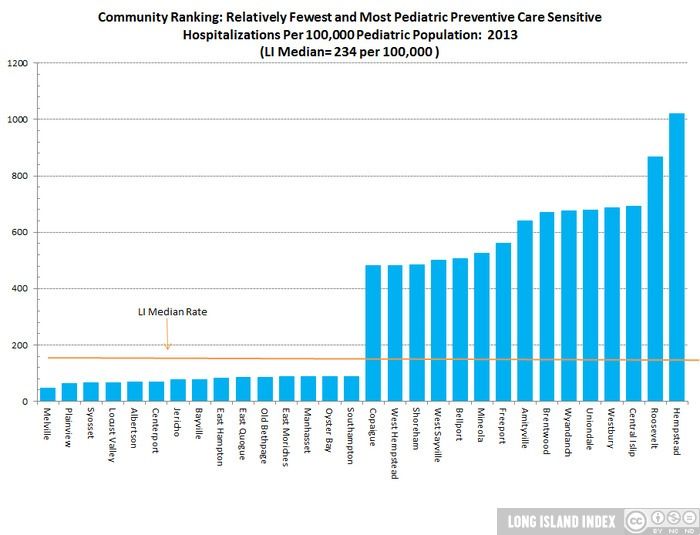Poorer communities have significantly higher rates of preventable hospitalizations for a series of illnesses.
Why is this important?
Health care continues to be a crucial issue for Long Islanders. Ensuring that all residents, children and adult, have access to quality care that they can afford is an essential ingredient in the social fabric. It is a well-established fact that when people have access to preventive care, they stay healthier, and recover more quickly when they do fall ill or get injured. In contrast, when people do not seek preventive care or delay treatment for possible or actual symptoms, their conditions tend to be more serious, they take longer to heal, and overall treatment is more expensive.
How are we doing?
Pediatric Quality Indicators (PDIs) are measurements of hospitalizations for diagnoses associated with preventive care sensitive conditions (i.e., conditions for which adequate preventive and early treatment generally preclude the need for hospitalizations). The PDIs establish admission and discharge rates for preventive care sensitive conditions among children. Here we use five indicators associated with pediatric hospitalizations: asthma, diabetes, gastroenteritis, perforated appendix, and urinary tract infection. We have combined the individual PDIs into a single scale that measures overall preventive care sensitive hospitalizations per 100,000 pediatric population for each community on Long Island as designated by zip code.
The accompanying chart shows the incidences of preventable hospitalizations for the combination of the above-mentioned five conditions for the fifteen communities with the lowest and the fifteen communities with the highest rates of incidence. It can be seen quite clearly that the most heavily impacted communities have significantly greater rates of preventable pediatric hospital admissions. On average, the admission rate for the high-PDI group is about 800% higher than for the low-PDI group of communities. The community with the highest admission rate is Hempstead. It has a preventable pediatric admission rate that was 22 times the rate of the community with the lowest rate (Melville). In addition, it is evident that those communities in the high-PDI group on average tend to have lower median incomes, higher rates of poverty, and greater proportions of residents of color.
